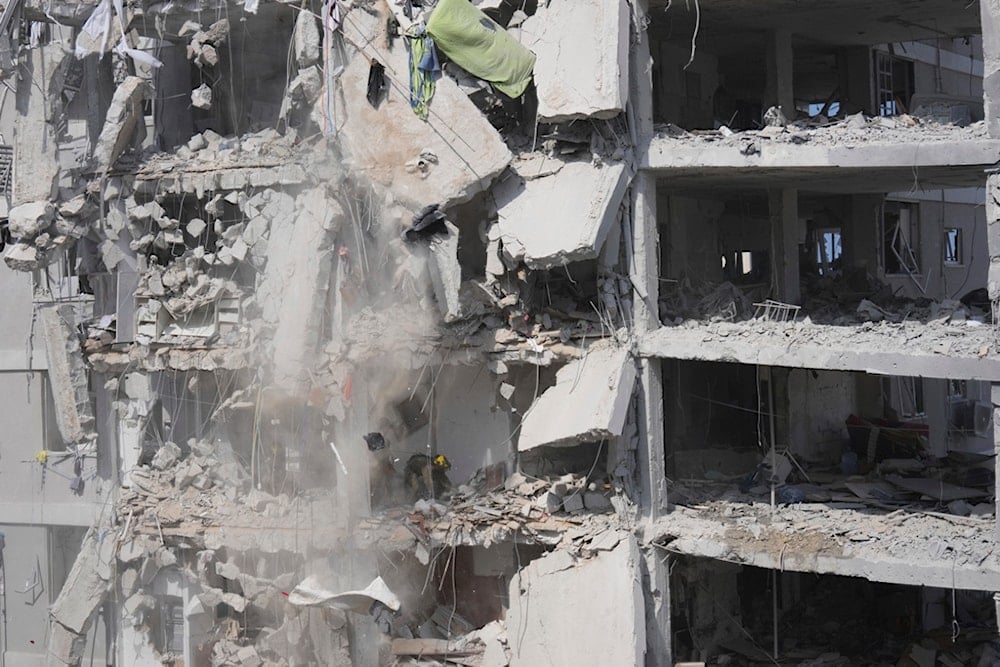'Israel' concealed damage inflicted by Iran in war, report finds
Iran struck five Israeli military sites during the June war, satellite data shows, despite Israeli military censorship and efforts to downplay damage.
-

Concrete and rubble fall from a heavily damaged building as Israeli soldiers search for survivors in a residential area hit by a missile fired from Iran, near Tel Aviv, occupied Palestine, Sunday, June 15, 2025 (AP)
The Israeli regime reportedly concealed the extent of damage inflicted by Iranian missile strikes on five of its military facilities during the recent 12-day war, according to a report published Saturday by The Telegraph, citing radar satellite data from researchers at Oregon State University.
The data suggests that six Iranian missiles successfully hit military targets across the northern, central, and southern regions of occupied Palestine, including the Tel Nof air base, a logistics site, and an intelligence center.
The report underscores the growing challenges faced by the Israeli occupation’s air defense systems, which, while allegedly intercepting most incoming missiles, appeared to be increasingly penetrable during the initial eight days of the exchange.
According to The Telegraph, strict military censorship laws issued by the Israeli regime contributed to the suppression of information regarding the strikes and the extent of the damage. The Israeli military has so far declined to comment on the missile interceptions or facility damage.
Israeli censorship hindering assessment of damage from Iranian strikes
"Israel" has admitted to being struck by more than 50 missiles during its 12-day war on Iran, but the full scope of the damage may never be revealed due to strict press censorship.
Such media restrictions are long-standing in "Israel", where any content, written or visual, considered potentially harmful to the vaguely defined notion of “national security” can be legally suppressed.
Recently, the Israeli regime has further tightened its grip on wartime reporting.
Last week, Israeli police cut off broadcasts by multiple foreign news agencies reporting from locations hit by Iranian missiles, while footage published by The Times of Israel showed an Israeli police officer demanding that a cameraman surrender his recording equipment.
Israeli police stormed the offices of foreign TV news teams following their coverage of missile strikes in the Haifa region, which reportedly hit sensitive military sites.
Censorship intensifies amid military setbacks
Under current regulations, any footage or reporting from a “combat zone or missile impact site” must receive prior written approval from the military censor, according to the Israeli Government Press Office, which also oversees journalist accreditation.
The rules are especially strict when missile strikes hit near sensitive sites such as military installations, oil refineries, or other strategic infrastructure.
Jerome Bourdon, a professor of media sociology at Tel Aviv University, stated, "We probably will never know the full extent of the damage."
According to Bourdon, the increasingly restricted media environment is "a very clear desire to reverse the narrative," noting that the war on Iran comes as "Israel" faces growing global condemnation for its ongoing aggression on Gaza, which has killed tens of thousands and sparked a severe humanitarian crisis.
Some 41,000 damage claims
A recent report by the Israeli financial daily Calcalist has revealed the extensive material losses suffered by the Israeli occupation following its war on Iran, with over 41,550 compensation claims filed so far by affected settlers.
The data shows that the majority of the damage resulted from direct hits to buildings, with 32,975 claims submitted for homes and other structures. An additional 4,456 claims were made for damages to household appliances and equipment, while 4,119 claims were related to vehicle damage.
Initial estimates place the total cost of direct damage at over 5 billion shekels (approximately $1.3 billion), though thousands of cases remain under review or are yet to be formally filed.
The report also noted that around 18,000 settlers were evacuated from various areas due to destruction caused by Iranian retaliatory strikes during the war.

 4 Min Read
4 Min Read










